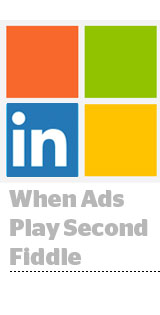 Microsoft and LinkedIn both have advertising businesses. But Microsoft’s $26.2 billion acquisition of LinkedIn wasn’t about advertising. At least, that’s not the main reason.
Microsoft and LinkedIn both have advertising businesses. But Microsoft’s $26.2 billion acquisition of LinkedIn wasn’t about advertising. At least, that’s not the main reason.
“It’s less about ad tech and more about mar tech,” said William Furlong, a former Bizo executive and current adviser and consultant.
Forrester VP and principal analyst Melissa Parrish agreed. While it can be tempting for those in the ad business to look at this in terms of their industry, she said, “the advertising possibilities were not the reason for the acquisition.”
The most intermingling will happen between LinkedIn’s social network and Microsoft’s business products, including its Dynamics CRM. Which makes sense, because advertising isn’t the main revenue driver for Microsoft or LinkedIn.
That said, there are still some interesting opportunities for advertising.
One is mingling LinkedIn and Microsoft ad inventory. Microsoft sells direct-sold ads through AOL and its programmatic ones through AppNexus.
AOL and AppNexus both declined to comment because it was too early for them to have a perspective on the acquisition, but Parrish has an idea of what’s on their mind. “They want to know if they get their hands on the LinkedIn inventory in any kind of way,” she said.
So far, only the reverse has been established: LinkedIn sponsored posts going out across Microsoft sites. LinkedIn CEO Jeff Weiner said in a letter to his employees that the deal would allow its advertisers to “reach Microsoft users anywhere across the Microsoft ecosystem, unlocking significant untapped inventory.”
While this makes sense on the surface, it’s worth noting that LinkedIn’s previous foray into off-network ad sales ended up with it closing the initiative and taking a $50 million write-down.
But Microsoft isn’t off-network, Furlong said. “When they shut down the ability to reach LinkedIn executives off-site, it was about keeping everything in that walled garden, and that garden has increased three- to fourfold.”
Microsoft might also see LinkedIn as a way to return to the ad business, focusing on B2B advertising.
“This [acquisition] is all about B2B,” Furlong said. “If they have the pipes in place, and a bigger audience, bigger scale and a different CEO and direction, maybe they’ll get themselves back in the ad business, but with the business segment.”
That could even include ad placements in Microsoft software, Furlong said, like PowerPoint or Outlook, if Microsoft chooses to go in that direction.
AOL and AppNexus, the companies most likely to be affected by the acquisition, shouldn’t expect any quick changes, Furlong predicted. “I’d venture to guess they have time on their side. This is more about product, audience and data integrations versus them saying, ‘Let’s go build a new ad business.’”













